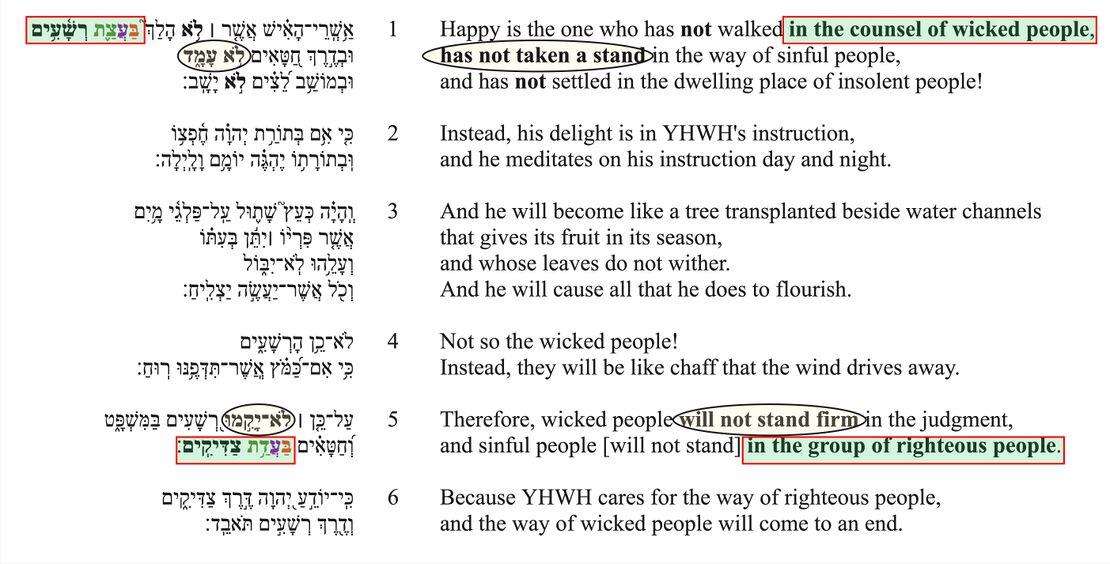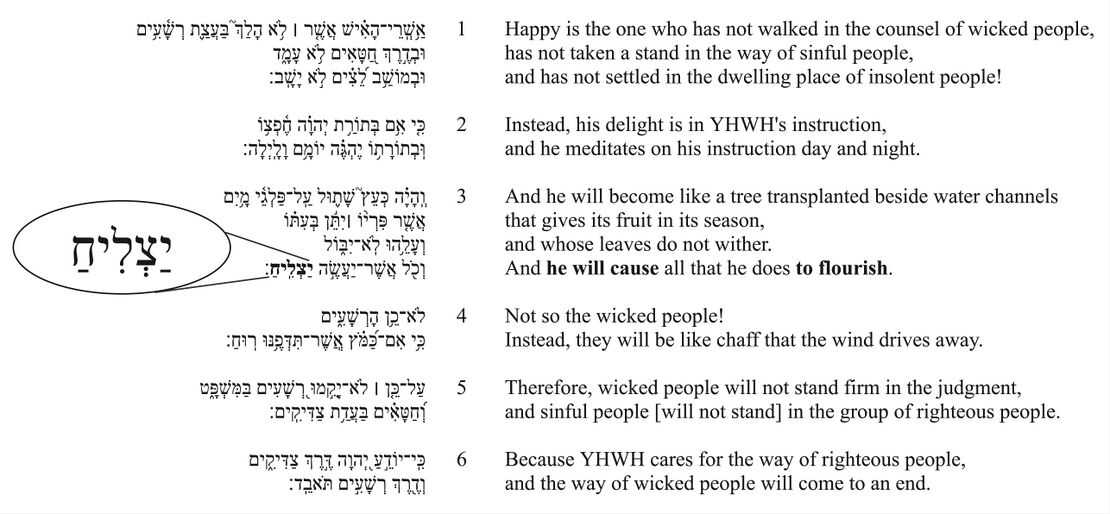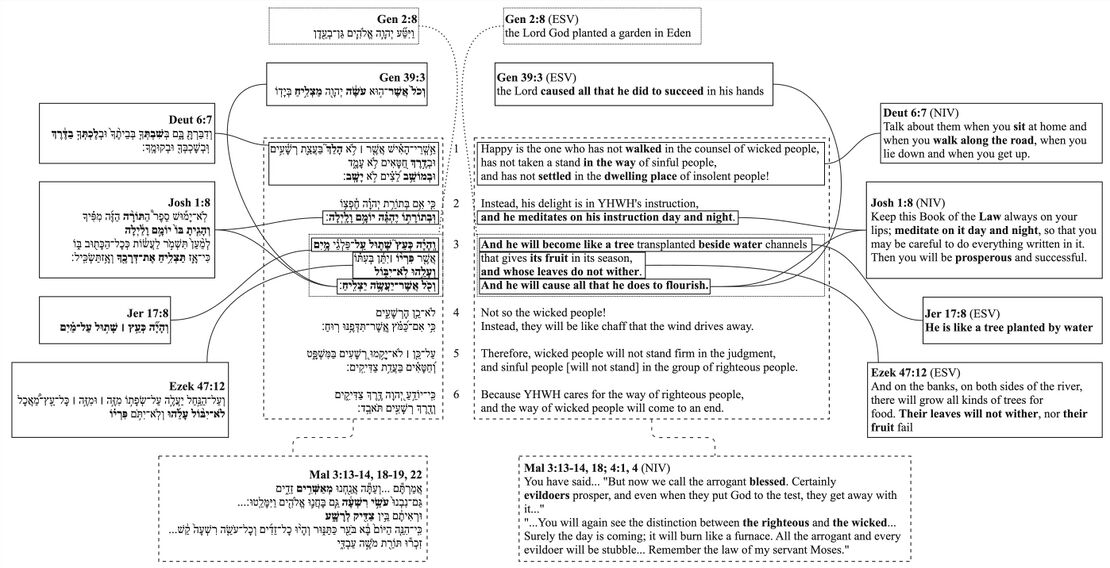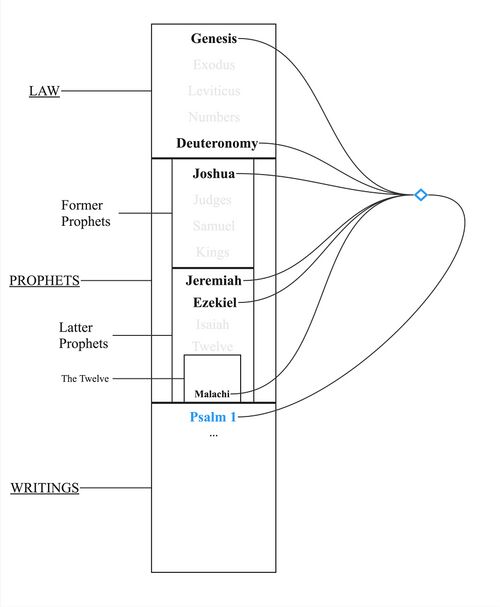Psalm 1 Poetic Features
Poetic Features
In poetic features, we identify and describe the “Top 3 Poetic Features” for each Psalm. Poetic features might include intricate patterns (e.g., chiasms), long range correspondences across the psalm, evocative uses of imagery, sound-plays, allusions to other parts of the Bible, and various other features or combinations of features. For each poetic feature, we describe both the formal aspects of the feature and the poetic effect of the feature. We assume that there is no one-to-one correspondence between a feature’s formal aspects and its effect, and that similar forms might have very different effects depending on their contexts. The effect of a poetic feature is best determined (subjectively) by a thoughtful examination of the feature against the background of the psalm’s overall message and purpose.
No Standing
If an emendation or revocalization is preferred, that emendation or revocalization will be marked in the Hebrew text of all the visuals.
| Emendations/Revocalizations legend | |
|---|---|
| *Emended text* | Emended text, text in which the consonants differ from the consonants of the Masoretic text, is indicated by blue asterisks on either side of the emendation. |
| *Revocalized text* | Revocalized text, text in which only the vowels differ from the vowels of the Masoretic text, is indicated by purple asterisks on either side of the revocalization. |
Feature
There are striking correspondences between v. 1 and v. 5. The clauses in both verses are negated (לֹא, "not"), and both verses contain motion verbs (e.g., "take a stand" in v. 1, "stand firm" in v. 5). In addition to these correspondences, the phrase, "counsel of wicked people" (בַּעֲצַת רְשָׁעִים) in v. 1a is very similar to the phrase, "group of righteous people" (בַּעֲדַת צַדִּיקִים) in v. 5b. Both phrases begin with a bet preposition ("in") followed by a two-part construct chain ("counsel of wicked people" // "group of righteous people"). The last part of each construct chain refers to the antonyms "wicked people" and "righteous people" respectively. The first parts contain words that sound remarkably similar to each other: בַּעֲצַת (v. 1a) and בַּעֲדַת (v. 5b)—bet + 'ayin + dental (צ/ד) + taw.
Effect
The correspondence between v. 1 and v. 5 has a structural effect, serving as a frame around the main body of the psalm (vv. 1-5, see Poetic Structure).
The correspondence also creates a poetic reversal. Just as the righteous do not stand with the wicked in their wickedness (v. 1), so the wicked will not stand with the righteous in their righteousness (v. 5). The former is true by choice. The latter will be true by the judge's decree.
The Climax of Flourishing
If an emendation or revocalization is preferred, that emendation or revocalization will be marked in the Hebrew text of all the visuals.
| Emendations/Revocalizations legend | |
|---|---|
| *Emended text* | Emended text, text in which the consonants differ from the consonants of the Masoretic text, is indicated by blue asterisks on either side of the emendation. |
| *Revocalized text* | Revocalized text, text in which only the vowels differ from the vowels of the Masoretic text, is indicated by purple asterisks on either side of the revocalization. |
Feature
The final word of the psalm's first section (see Poetic structure) is יַצְלִיחַ ("cause to flourish").
- The verb צלח can refer to success on a journey (see e.g., Josh 1:8) as well as the to flourishing of a plant (see e.g., Ezek 17:9), and both of these images are prominent in Ps 1 (journey imagery in vv. 1, 6; tree imagery in v. 3).
- The verb יַצְלִיחַ is part of a network of intertextual connections that help to connect Ps 1 to both Joshua 1:8 and the Joseph story in Genesis (Gen 39:3, 23). (See Poetic Feature #3.)
- The subject of the verb is ambiguous. Is it the righteous person, the tree, or YHWH? See The Grammar of Psalm1:3d.
Effect
The word יַצְלִיחַ, the final, climactic word of the psalm's first, celebratory section, is arguably the most poetically rich word in the psalm. It unites in itself the two most important images in the psalm: the image of a journey and the image of a flourishing tree. Furthermore, with its ambiguous subject, it ties together the flourishing of the tree, the flourishing of the righteous person, and YHWH as the cause of all flourishing. Finally, it also helps to evoke the characters of Joshua and Joseph—two powerful examples of faithfulness and flourishing under YHWH's care.
Day and Night Meditation
If an emendation or revocalization is preferred, that emendation or revocalization will be marked in the Hebrew text of all the visuals.
| Emendations/Revocalizations legend | |
|---|---|
| *Emended text* | Emended text, text in which the consonants differ from the consonants of the Masoretic text, is indicated by blue asterisks on either side of the emendation. |
| *Revocalized text* | Revocalized text, text in which only the vowels differ from the vowels of the Masoretic text, is indicated by purple asterisks on either side of the revocalization. |
Feature
Psalm 1 alludes to multiple passages in the Old Testament.
- The language of "meditating" (הגה) on YHWH's "instruction" (תּוֹרָה) "day and night" (יוֹמָם וָלַיְלָה) in v. 2 is a clear allusion to Joshua 1:8.[1] The words "way" (דֶּרֶךְ, vv. 1, 6) and "make successful" (הצליח, v. 3) are also found in Josh 1:8.
- The initial description of the righteous person as a tree in v. 3a is almost identical to the similar description in Jeremiah 17:8. Where the description differs from Jeremiah (e.g., water channels, leaves not withering), Psalm 1 appears to be drawing from other passages of Scripture, especially Ezekiel 47:12.[2]
- The language of Ps 1:3d, in addition to echoing Josh 1:8, has strong connections to Genesis 39:3 and the description of Joseph (who, notably, was Joshua's ancestor, Joshua being from the tribe of Ephraim, Joseph's son). The connection is strengthened by the fact that Joseph is elsewhere described as a fruitful tree by a water source (cf. Gen 49:22).[3]
- The Garden of Eden imagery in v. 3 (see notes below) recalls the first chapters of Genesis, when YHWH plants a garden and places the man in it. (Psalm 1's position at the beginning of Book I of the Psalter, with its five books corresponding to the Torah's five books, further strengthens the connection with the beginning of Genesis).
- The language of "walking," "way," and "sitting/settling" recalls Deuteronomy 6 and the command to love YHWH with one's whole being.[4]
- In the order of the Hebrew canon, the Psalter follows immediately after Malachi.[5] It is surely no coincidence that the themes of Ps 1 are also themes at the end of Malachi (e.g., "blessedness," righteous vs wicked, chaff, Torah, coming judgment). Psalm 1 picks up where Malachi leaves off.[6] Even if Ps 1 was written before Malachi (such that the connections are not to be classified as allusions by the author), their juxtaposition in the canon must reflect the thoughtful work of an editor.
The passages to which Ps 1 alludes were not randomly chosen. The psalm alludes to the first and last books of the Torah (Genesis and Deuteronomy) as well as to the first and last books of the Prophets (Joshua and Malachi), including the first book of the latter prophets (Jeremiah), according to the order in the Talmud (Baba Bathra 14b).[7]
Effect
Psalm 1, which celebrates meditation on YHWH's instruction (v. 2), is itself a meditation on that instruction. The psalmist models what he celebrates; he practices what he preaches. And not only does the psalm show what it looks like to meditate on YHWH's instruction, it also provides a guided tour through YHWH's instruction. The psalm takes us through the Law and the Prophets and distills the essence of their teaching into a short but powerful poem.
Repeated Roots
The repeated roots table is intended to identify the roots which are repeated in the psalm.
| Repeated Roots legend | |
|---|---|
| Divine name | The divine name is indicated by bold purple text. |
| Roots bounding a section | Roots bounding a section, appearing in the first and last verse of a section, are indicated by bold red text. |
| Roots occurring primarily in the first section are indicated in a yellow box. | |
| Roots occurring primarily in the third section are indicated in a blue box. | |
| Roots connected across sections are indicated by a vertical gray line connecting the roots. | |
| Section boundaries are indicated by a horizontal black line across the chart. | |
Notes
- The most repeated word in the psalm is the wicked (רשׁעים). Some have suggested that "the wicked" in Ps 1 are a foil for the righteous (and thus in the background). But the fourfold repetition suggests a more prominent role for the wicked in the logic of the psalm, which is interested, not just in the fate of the righteous, but in the fate of the wicked. Cf. Ps. 73. "How long will the wicked prosper?" Mal 3: "How long will we call the wicked happy (אשרי)!" These two passages (Ps 73 and Mal 3) are especially important, because the latter (Mal 3) occurs immediately before Ps 1 in the Hebrew canon, and the former (Ps 73) parallels Ps 1 as the introductory psalm to the second half of the Psalter (Books II–V; Pss 73-150).
- The psalm is framed by the repetition of the word way (דרך) and also, though to a lesser extent, by the word sinful people (חטאים).
- The words "so" / "therefore" (כן) and "righteous" (צדיקים) give cohesion to vv. 4-5 and vv. 5-6 respectively.
- The word instruction (תורה) in v. 2 is the only example in the psalm of a word being repeated twice within a single verse. The repetition gives thematic prominence to this word.
- The divine name YHWH occurs twice in the psalm (vv. 2, 6). In the first occurrence, YHWH is the source of the person's "instruction" (v. 2), and in the second occurrence, he is the one who "cares for" the righteous on their journey (v. 6). The repetition creates a link between YHWH's instruction and YHWH's care. The more a person "knows" YHWH's instruction (cf. v. 2), the more they experience YHWH's "knowing" them (v. 6).
- ↑ Cf. Schnittjer 2021, 479.
- ↑ See Creach 1999.
- ↑ Cf. Mitchell 2021, 59.
- ↑ Cf. Ibn Ezra; Schnittjer 2021, 479.
- ↑ According to the arrangement in Baba Bathra 14b, the book of Ruth occurs between the Psalter and the Twelve. But Ruth is probably functioning as a kind of prologue to the Psalter, introducing the person of David.
- ↑ Cf. Barbiero 1999.
- ↑ Peter Gentry 2024 has argued that the order in Baba Bathra 14b is the earliest known order and “represents the arrangement in the Temple Library.”










